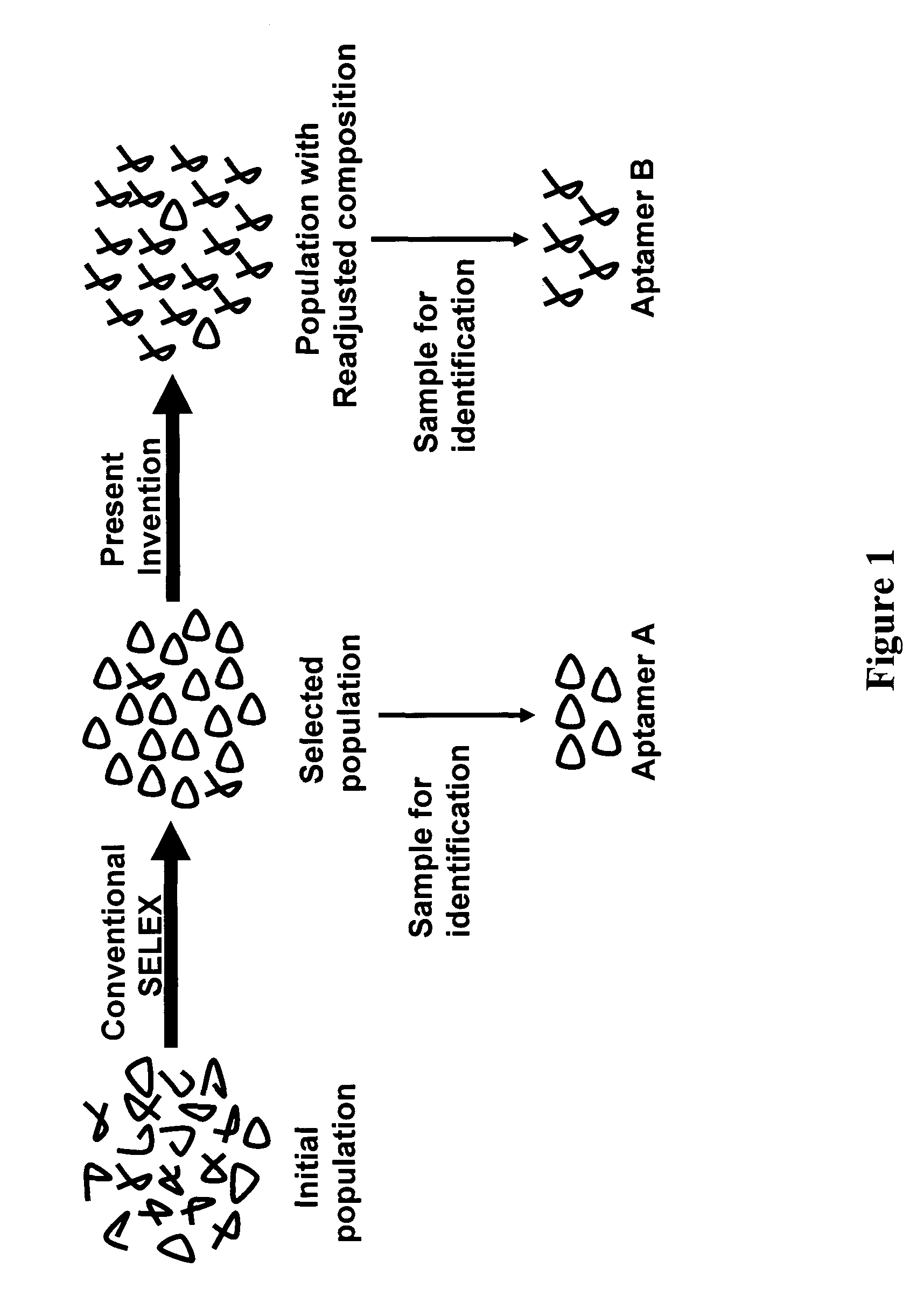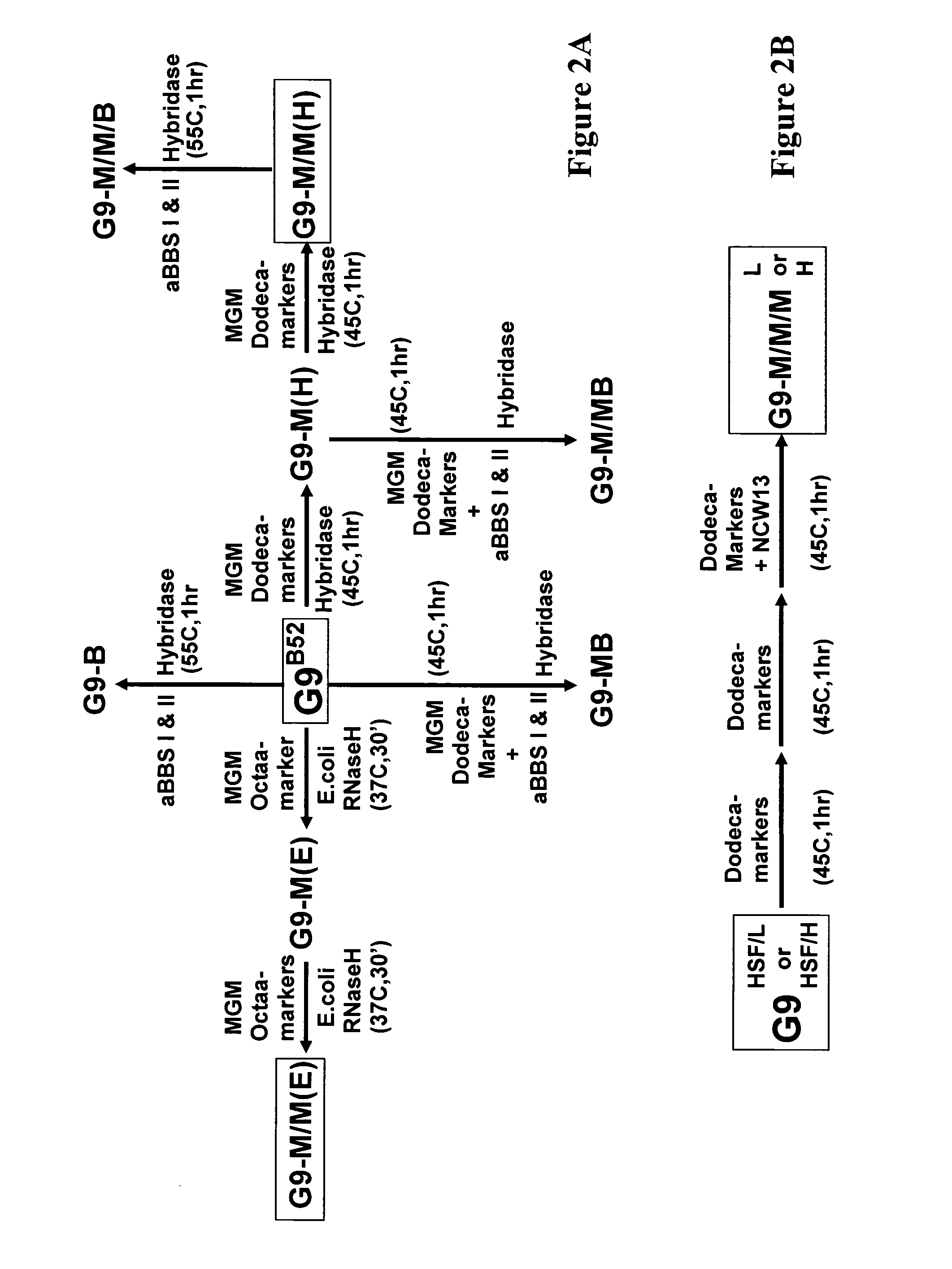Exhaustive selection of RNA aptamers against complex targets
a aptamer and complex target technology, applied in the field of molecular biology and genetics, can solve the problems of insufficient method efficiency, no literature, and extra handling, and achieve the effect of eliminating methods that are not efficient enough
- Summary
- Abstract
- Description
- Claims
- Application Information
AI Technical Summary
Benefits of technology
Problems solved by technology
Method used
Image
Examples
example 1
MGM Restriction on the B52 Selected G9 Pool
[0072]To utilize the RNaseH activity for the purpose of selectively eliminating an RNA sequence family, several issues needed to be addressed before the procedure could be applied to a heterogeneous sequence pool. The marking oligonucleotide has a minimal required length for it to anneal to the target sequence and be recognized by the enzyme. This length may exceed the length of the consecutive consensus sequence of the aptamer to be eliminated. In order not to affect any other sequence in the pool, the fidelity of hybridization must be ensured. Longer oligonucleotides carry more information and thus are more specific if the reaction is carried out at or near its melting temperature. Therefore an RNaseH that is stable over a wide range of temperature is desirable. These conditions were tested on three single representative MGM sequences, with a random sequence as control, before extending this method to the sequence pools. Marking oligonucl...
example 2
Restriction of MGM, BBS, or Both, on the B52 selected G9 Pool
[0076]As described herein above, in addition to mining less prevalent RNA aptamer families from a selected pool, this population restriction method can be extended to a general approach for generating different ligands to all of the targets in a mixture. To test the efficiency and versatility of this method, both the MGM family and the BBS family were removed, successively or simultaneously, from the B52 selected G9 pool and its derivatives. The relationship among the pools derived from B52 G9 is shown in FIG. 2. In contrast to the MGM family, the BBS family has a highly homologous, long consensus, and can be marked by two 17-mer sequences with only three positions different between them. The reaction was carried on at a higher temperature, 55° C., when only BBSs were to be eliminated, further increasing the specificity. Depletion of either or both families was confirmed by Southern dot blot analyses with the marking oligo...
example 3
MGM Restriction on the HSF Selected G9 Pools and Subsequent Selection of an HSF Aptamer
[0077]To confirm the efficiency of the method developed in previous examples, and to provide a more general case of exhaustive selection and matrix-binding reduction, two other selections were performed against the Drosophila heat shock factor (HSF) (Wu, “Heat Shock Transcription Factors: Structure and Regulation”, Ann. Rev. Cell Dev. Biol. 11:441-469 (1995), which is hereby incorporated by reference in its entirety), which regulates the activation of heat shock gene transcription by binding to specific promoter elements.
[0078]The first stage of the selection used as the starting material the same initial unselected RNA pool as that used in the B52 selection, The target HSF was expressed and purified as a GST fusion protein in E. coli. The selection scheme and conditions were almost identical to that used for B52 except the following minor modifications. In one selection (designated L), a negative...
PUM
| Property | Measurement | Unit |
|---|---|---|
| pH | aaaaa | aaaaa |
| temperature | aaaaa | aaaaa |
| temperature | aaaaa | aaaaa |
Abstract
Description
Claims
Application Information
 Login to View More
Login to View More - R&D
- Intellectual Property
- Life Sciences
- Materials
- Tech Scout
- Unparalleled Data Quality
- Higher Quality Content
- 60% Fewer Hallucinations
Browse by: Latest US Patents, China's latest patents, Technical Efficacy Thesaurus, Application Domain, Technology Topic, Popular Technical Reports.
© 2025 PatSnap. All rights reserved.Legal|Privacy policy|Modern Slavery Act Transparency Statement|Sitemap|About US| Contact US: help@patsnap.com



